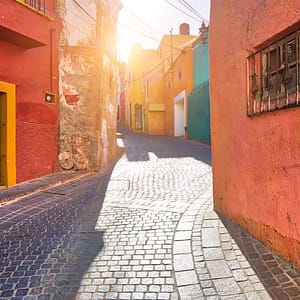European vs. Brazilian Portuguese
Spoken by about 279 million people worldwide, Portuguese is one of the fastest-growing western languages. When translating into Portuguese, it’s important to understand the variants—who speaks what and where? European and Brazilian Portuguese have evolved separately through years of cultural and historical differences. In this article, we examine the different forms of Portuguese, look at the distinctions, and explore where each form is used today.
A Brief History of European Portuguese
Portuguese originated more than 2,000 years ago when Roman soldiers arrived on the Iberian Peninsula (today’s Portugal and Spain) and introduced Vulgar Latin—from which all Romance languages derived. Due to its Latin origins, today’s Portuguese is written in the Latin alphabet, and nearly 90% of its lexicon is derived from Latin.
On the Iberian Peninsula, Old Portuguese slowly distinguished itself from other Romance languages and took root along the Atlantic coast. In the eighth century, as Arabic-speaking Moors from North Africa and the Middle East conquered the peninsula, the Portuguese language become intertwined with Arabic. Many words of Arabic origin remain today, such as almofada (cushion), azeitona (olive), and garrafa (bottle), to name a few.
Between the 14th and 16th centuries, Portuguese proliferated far and wide beyond the Iberian Peninsula, spread by soldiers, sailors, and merchants. It developed into a lingua franca in Asia and Africa, where it was used for communication between local officials and Europeans of all nationalities.
Today, European Portuguese is primarily spoken in Portugal and is the country’s official language. There are multiple dialects of the spoken language—notably northern, central, and southern—with the most significant difference being the stresses on the vowels.
Brazilian Portuguese
While Portuguese originated in Europe, it is now far more widely spoken in South America. In fact, only 5% of current day speakers live in Portugal.
The Europeans brought the Portuguese language to Brazil when they colonized the country in the 16th century. Over time, the language was influenced by the many diverse cultures converging in Brazil at the time—indigenous people of the Americas, European immigrants, and African slaves.
Today, Brazil has the largest number of Portuguese speakers in the world (approximately 215 million people). Due to the proliferation of Brazilian culture (and Brazilian soap operas) around the world, Brazilian Portuguese has become well known online and familiar to the many Portuguese speakers in Europe, Africa, and Asia.
Differences Between European Portuguese and Brazilian Portuguese
European and Brazilian Portuguese are mutually intelligible, and those who speak one language can understand the other. While there are many similarities, there are also striking differences in grammar, syntax, vocabulary, and pronunciation.
- One of the most significant differences between European and Brazilian Portuguese is the placement and use of object pronouns. In European Portuguese, pronouns come after the verb, while in Brazilian Portuguese the pronoun comes before.
- In Portuguese (like Spanish), pronouns are different depending on formality. Brazilians use the word você for both formal and informal situations, making it akin to the universal “you” in English. In Portugal, however, tu is used for friends and family, and other casual situations, while você is reserved for more formal situations. The ending form of the verb used with tu or você changes accordingly.
- Another difference is in the use of gerunds (a form of a verb that ends in -ing and is used as a noun). While Brazilians use them like we do in English, Europeans avoid the use of gerunds and instead use a preposition followed by the verb in the infinitive. For example, “I’m eating” in Brazil is Estou comendo, while in Portugal one would say Estou a comer.
- There are some differences in spelling. One example is the word “reception,” which is spelled receção in European Portuguese. Brazilian Portuguese adds an audible p to form recepção.
- Capitalization is not consistent. Europeans capitalize the names of months and days of the week, whereas they are not capitalized in Brazil.
- Other words are completely different from one language to the next, because new concepts were introduced into the language separately. For example, “Bus” is Ônibus in Brazil, and Autocarro in Europe. Refrigerator is Geladeira in Brazil and Frigorífico in Europe.
- Brazilian Portuguese continues to add new words. European Portuguese, however, is more resistant to the influx of new vocabulary and the assimilation of foreign words. Therefore, an increasing number of words in the Brazilian variant are not familiar to Europeans.
- In spoken form, Brazilian Portuguese is thought by many to be the more musical form of the language. Thanks to its open vowels, it is considered pleasing to the ear. Brazilians pronounce every single syllable in a word while in Portugal people do not, leading the European variety to sometimes be described as quiet and muffled.
Let's chat!
Reach out to discuss your next translation project with a member of our team.
Portuguese in the U.S.
In the U.S., Portuguese is the eleventh most popular non-English language, spoken by approximately 678,000 people. The largest communities of Portuguese speakers are in Massachusetts and Rhode Island, followed by the New York/New Jersey area.
European Portuguese speakers arrived in America through two major waves of immigration. The first settlers came in the early 1800s, drawn by the whaling industry. The second wave arrived in the 1950s, brought by the political climate in Portugal, as well as volcanic activity in the region. Today, Massachusetts has more residents with Portuguese ancestry than any other state in the country, while Rhode Island has the nation’s densest Portuguese population.
Brazilian migration to the United States took place later, driven by poor economic conditions and hyperinflation in Brazil throughout the 1980s and 1990s. In recent years, Brazilians have become one of the country’s fastest-growing immigrant groups, and the greater Boston area today has the highest number of Brazilian-born residents in the country.
Cape Verdean Portuguese in the U.S.
Cape Verde is a country in the central Atlantic with an archipelago of ten volcanic islands. In the mid-nineteenth century, when drought and poverty drove many Cape Verdeans to work on whaling ships, many began settling in the whaling port of New Bedford, Massachusetts. Thus began a stream of immigration to southeastern Massachusetts that peaked between 1890-1921. Migration peaked again in the 1980s as new Cape Verdean immigrants found their way to New England, thanks to the area’s historic connection to the islands. Today, the population continues to grow. In Massachusetts alone, the Cape Verdean community has grown 58% since 2000.
Cape Verdeans speak the European form of the language. However, there are enough small differences to make Cape Verdean Portuguese its own unique dialectical variety of the European variant.
Featured Services
Learn more about…
Portuguese Around the World
The use of Portuguese around the world is on the rise, especially in Africa. By mid-century the majority of the world’s Portuguese speakers are expected to be African. It is estimated that by 2050 Portuguese-speaking African countries will have a combined population of 83 million.
Portuguese is the official language of six African countries that are former colonies of the Portuguese empire: Angola, Cape Verde, Equatorial Guinea, Guinea-Bissau, Mozambique, and São Tomé and Príncipe. It is spoken as a second language by many in countries such as South Africa and Senegal, due to migrants from Portuguese-speaking countries. The language is expected to see its largest growth in sub-Saharan Africa, resulting largely from the expansion of education and rapid population growth. Due to its history, the language spoken in Africa is closer to European Portuguese, however some aspects, like the pronunciation of unstressed vowels, resemble the Brazilian variant.
In Asia, Portuguese is also becoming more popular as diplomatic and financial ties grow stronger between China and Portuguese-speaking countries. East Timor has seen a large increase in Portuguese speakers in recent years, and Macau is becoming a Chinese center for Portuguese-language learning.
Portuguese Translation
Portuguese is an important language for global communication, business, and international relations, and the need for English into Portuguese translation is increasing among U.S.-based organizations.
In translation, it is always important to use specific language that sounds natural to the reader. Although European and Brazilian Portuguese are mutually intelligible, the differences are significant enough that Brazilian text will not sound natural to a European, and vice versa. Therefore, to keep the language smooth and natural-sounding, it is important to be sensitive to the dialects spoken by the target audience.
When translating for a large U.S. audience, Brazilian Portuguese will typically be appropriate. However, be considerate of smaller communities in the U.S. for whom European or Cape Verdean Portuguese would be the best fit.
 Named to the 2024 Inc. 5000 list of fastest-growing companies and ranked among the world’s top 100 language service providers by CSA Research
Named to the 2024 Inc. 5000 list of fastest-growing companies and ranked among the world’s top 100 language service providers by CSA Research

